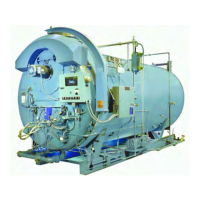Chapter 6 — Adjustment Procedures
Part No. 750-184 6-13
tions, refer to the trouble shooting section in the technical bulle-
tin.
P. GAS PRESSURE AND FLOW INFORMATION
Because of variables in both the properties of gas and the supply
system, it will be necessary to regulate the pressure of the gas to a
level that produces a steady, dependable flame that yields highest
combustion efficiency at rated performance yet prevents overfiring.
Once the optimum pressure has been established, it should be
recorded and periodic checks made to verify that the regulator is
holding the pressure at this level. Occasional modification in fuel
composition or pressure by the supplier may, at times, require
readjustment to return the burner to peak efficiency.
Pressure
The gas supplied must provide not only the quantity of gas
demanded by the unit, but must also be at a pressure high enough
to overcome the pressure loss due to the frictional resistance
imposed by the burner system and the control valves.
The pressure required at the entrance to the burner gas train for
rated boiler output is termed “net regulated pressure.” The gas
pressure regulator must be adjusted to achieve the pressure to
assure full input.
The pressure requirement varies with boiler size, altitude, and type
of gas train. See Tables 6-1 to 6-3.
The pressures listed are based on 1000 Btu/cu-ft natural gas at
elevations up to 700 feet above sea level. For installation at higher
altitudes, multiply the selected pressure by the proper factor from
Table 6-5.
Gas Flow
The volume of gas flow is measured in terms of cubic feet and is
determined by a meter reading. The gas flow rate required for
maximum boiler output depends on the heating value (Btu/cu-ft) of
the gas supplied and boiler efficiency. The supplying utility can
provide precise information on fuel heating value.
INPUT = OUTPUT x 100%
EFFICIENCY
GAS FLOW = INPUT
GAS BTU’s/Ft
3
= OUTPUT x 100
EFFICIENCY x GAS BTU’s/Ft
3

